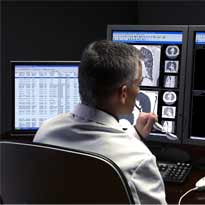South west trusts reap PACS benefits
- 21 January 2014

Five trusts in the South West of England are beginning to reap the benefits of a new Insignia picture archiving and communications system.
The consortium of trusts – made up of Plymouth Hospitals, Northern Devon Healthcare, South Devon Healthcare, Royal Cornwall Hospitals and Royal Devon and Exeter – completed implementation in September 2013, a few months behind schedule.
Andy Blofield, director of the ICT shared service, said that the trusts had decided to spend a little longer on integrity testing to make sure the new PACS was working smoothly.
One challenge had been the migration of annotated data: in the old GE PACS, annotations were held in a separate file, whereas in the Insignia system, the annotations are merged with the image.
“We had to do a lot of integrity checking to make sure we weren’t missing annotations, as they can be quite important to the meaning of the image,” said Blofield.
While there are still some issues to resolve, the new PACS is proving its worth.
“It’s very well thought of by the clinicians. It’s got a lot more functionality than our previous PACS, which is one of the reasons we bought Insignia in the first place,” he said.
The trusts have seen the benefits of being able to integrate the imaging systems used by other disciplines, such as cardiology, which wasn’t possible under their previous systems, which were obtained on National Programme for IT contracts a decade ago.
“From our perspective, as along as all the images are stored centrally, the application you use to see them doesn’t make a lot of difference.
"So if cardiology are using Carddas, as long as all the imagery it produces is on the Insignia PACS, it doesn’t matter that they’re accessing it using Carddas. That’s what we weren’t able to do before, and that’s a big benefit of having our own contract,” explained Blofield.
Another improvement has been the introduction of disaster recovery.
“In the system we had through the national programme, there was just one server room – there was no disaster recovery at all. If it died, they sent a man and a van and a spanner down and they tried to fix it. Now it’s a core part of our infrastructure. It’s a mission-critical system,” he added.
The Insignia account is being managed by all five trusts in the consortium.
“There are obvious economies of scale in doing that,” said Blofield. “You’ve got better buying power there with five large acute trusts all saying the same thing – the supplier listens a lot more than they potentially would with five individual trusts all saying the same thing separately.”
The Insignia software has an HTML 5 viewer so once the trusts have upgraded to Windows 7, they plan to make PACS images available more widely. Potentially, GPs will be able to use the viewer to see patient images, while doctors on the ward will be able to share images on tablets.
“It’s useful for interfacing with the patient, to be able to sit alongside the patient on the ward and say, ‘You can see where your break is’,“ Blofield said.



